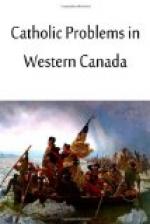The Protestant Churches in Canada are also falling in line in this universal movement for unity. “The United National Campaign” which marked 1919 with thirteen national conventions, represented the co-operative feature of various churches in a general “Forward Movement.” The war, we all know, has impeded the projected union between the Methodist, Presbyterian and Congregationalist denominations. There is hardly any doubt that this union will be effected in the near future. But as usual, while the East was deliberating, the forward and aggressive West was acting. Church-Union is an accomplished fact in many centres, particularly in the Province of Saskatchewan. Last October the “Union Church of Western Canada” held a convention in Regina and reported progress. Conditions in the West, especially in the rural districts, naturally favour this movement. The strong denominational feeling is becoming more and more a thing of the past. The identity of churches is being absorbed in “social service” work, and sectarian peculiarities considered “obsolete impertinences.”
These are the various manifestations of the “Church-Union Movement.” Although loose thinking and indefiniteness of purpose characterize most of these various moves, a close analysis reveals two different underlying principles which support and explain them. As an Anglican clergyman stated: “There are two courses open, uniting on points of agreement and allowing the differences to settle themselves, or facing differences with a view of settling them.” The first course promotes a “co-operative union” in social and Christian work. This union does not interfere with matters of belief, but aims solely at the co-operation and co-ordination of all services which the Churches can render in the missionary, educational and social fields. It means a League or Federation of Churches, with a view to “greater efficiency.”
The other course goes deeper into the problem under discussion, for it has as object an “organic union.” This union means the fusing of all denominational creeds and forms of worship, or, at least, the acceptance by all of a certain doctrinal minimum as a basis of the entente cordiale. The Anglicans in the Conference of Lambeth, 1888, formulated the famous “Quadrilateral” whereby the Scriptures as Rule of Faith, the Apostles’ and Nicene Creeds, the two sacraments of Baptism and of Eucharist, and the Episcopacy or apostolic succession, are “as the irreducible minimum on which they would open negotiations for reunion.” [2]
II.
The Protestant Inter-Church Movement is a fact; we know its causes, its various manifestations, its ultimate aim. To what extent this universal movement reflects the general, deep and conscientious convictions of the masses, it would be hard to say. The prevalent indifference and profound ignorance as regards the specific tenets of each denomination would lead us to believe that this movement does not spring from the very soul-depths of the masses. Yet the fact is there, and assuredly of importance in the religious realm. What is the meaning of this fact? What is its message? For, every universal fact of that kind reveals and interprets an ideal.




